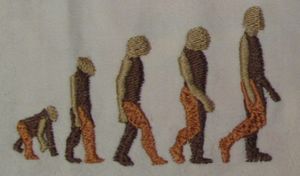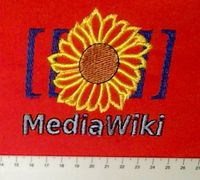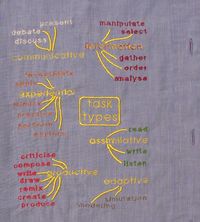Computerized embroidery in education: Difference between revisions
m (using an external editor) |
m (using an external editor) |
||
| Line 10: | Line 10: | ||
We believe that computer-controlled embroidery may have a more prominent place in education and for many different reasons. | We believe that computer-controlled embroidery may have a more prominent place in education and for many different reasons. | ||
For now, just a few ideas that I will expand with some theory - [[User:Daniel K. Schneider|Daniel K. Schneider]] | For now, just a few ideas that I will expand with some theory - [[User:Daniel K. Schneider|Daniel K. Schneider]] 12:31, 17 June 2011 (CEST) | ||
== Embroidery for identity building == | == Embroidery for identity building == | ||
| Line 26: | Line 26: | ||
* Display logos of favorite projects, software etc. | * Display logos of favorite projects, software etc. | ||
* Display figures and diagrams, turn a person into some kind of walking poster | * Display figures and diagrams, turn a person into some kind of walking poster | ||
[[image:Evolution-embroidered-2.jpg|thumb|200|I believe in evolution]] | |||
[[image:Mediawiki-logo-embroidered-test.jpg|thumb|200px|I like Mediawiki]] | |||
[[image:Elna-taxonomy-test-2.jpg|thumb|200px|Essential learning tasks]] | |||
== Embroidery design for learning vector graphics == | == Embroidery design for learning vector graphics == | ||
| Line 43: | Line 48: | ||
== Embroidery as contructionist learning object == | == Embroidery as contructionist learning object == | ||
Embroidered cloth or bands could help to organize role plays | According to [[Constructionist learning object|Zuckerman's taxonomy]] there are three kinds of constructionist learning objects | ||
# Construction & Design (Froebel tradition) and its modern digital variants (Papert and Resnick) | |||
# Conceptual Manipulation (Montessori) | |||
# Reality Role Play (Dewey) | |||
1 ) See embroidery for learning design and 2D drawing (above) | |||
2) ? | |||
3) Embroidered cloth or bands could help to organize role plays | |||
== Bibliography == | |||
* Dewey, J. (1938) Experience and Education, New York: Collier Books. | |||
* Fröbel, F. (1826) On the Education of Man (Die Menschenerziehung), Keilhau/Leipzig: Wienbrach | |||
* Montessori, M. (1916) The Montessori Method, New York: Schocken Books (1964 edition) | |||
* Resnick, M., Martin, F., Sargent, R., and Silverman, B. (1996). Programmable Bricks: Toys to Think With. IBM Systems Journal 35, 3, 443-452. | |||
* Zuckerman, Oren (2006, in preparation), Historical Overview and Classification of Traditional and Digital Learning Objects MIT Media Laboratory, 20 Ames Street, Cambridge, MA 02139. [http://llk.media.mit.edu/courses/readings/classification-learning-objects.pdf PDF] - [http://citeseerx.ist.psu.edu/viewdoc/summary?doi=10.1.1.94.7899 CiteSeer Abstract]. | |||
* Zuckerman, Oren (2010). Designing digital objects for learning: lessons from Froebel and Montessori, ''International Journal of Arts and Technology'' 3 (1) 124-135. {{ar}}. | |||
Revision as of 11:31, 17 June 2011
This article or section is currently under construction
In principle, someone is working on it and there should be a better version in a not so distant future.
If you want to modify this page, please discuss it with the person working on it (see the "history")
<pageby nominor="false" comments="false"/>
Introduction
Computer-controlled embroidery is a kind of Computer-aided design and manufacturing. An embroidery machine executes computer numerical control (CNC) files that are generated from the design software.
We believe that computer-controlled embroidery may have a more prominent place in education and for many different reasons.
For now, just a few ideas that I will expand with some theory - Daniel K. Schneider 12:31, 17 June 2011 (CEST)
Embroidery for identity building
In particular, younger students could create embroidery in (mostly) extra-curricalar classes that address societial isssues, like peace, envrionment, energy, migration etc. Creating wearable embroidery would engage learners in exposing views in public and not just the classroom.
Co-workers in an outfit that has such a machine could create identity-building designs.
Embroidery for communication
Academics and others could create embroidery to wear at events like conferences and that express a strong viewpoint, part of a theory or research.
Such embroidery could:
- Make strong statements
- Display logos of favorite projects, software etc.
- Display figures and diagrams, turn a person into some kind of walking poster
Embroidery design for learning vector graphics
Modern embroidery design often starts from "ordinary" vector graphics and between actual stitches, so-called embroidery objects are also represented as vector graphic objects.
Embroidery could awaken interest for IT in people who otherwise just stick to Word and Facebook.
Embroidery as introduction to design
Having students create designs will train them in design and in using design software. Design is important for our societies and should be taught more. Also, micro-fabrication will gain importance in the future and we should be ready for that.
Embroidery as motivator and post-production
Subject-specific designs could be motivators in project-oriented classes (nature, science, political). I.e. the idea is to have students create designs that represent knowledge in various forms.
Embroidery as contructionist learning object
According to Zuckerman's taxonomy there are three kinds of constructionist learning objects
- Construction & Design (Froebel tradition) and its modern digital variants (Papert and Resnick)
- Conceptual Manipulation (Montessori)
- Reality Role Play (Dewey)
1 ) See embroidery for learning design and 2D drawing (above)
2) ?
3) Embroidered cloth or bands could help to organize role plays
Bibliography
- Dewey, J. (1938) Experience and Education, New York: Collier Books.
- Fröbel, F. (1826) On the Education of Man (Die Menschenerziehung), Keilhau/Leipzig: Wienbrach
- Montessori, M. (1916) The Montessori Method, New York: Schocken Books (1964 edition)
- Resnick, M., Martin, F., Sargent, R., and Silverman, B. (1996). Programmable Bricks: Toys to Think With. IBM Systems Journal 35, 3, 443-452.
- Zuckerman, Oren (2006, in preparation), Historical Overview and Classification of Traditional and Digital Learning Objects MIT Media Laboratory, 20 Ames Street, Cambridge, MA 02139. PDF - CiteSeer Abstract.
- Zuckerman, Oren (2010). Designing digital objects for learning: lessons from Froebel and Montessori, International Journal of Arts and Technology 3 (1) 124-135. (Access restricted).


